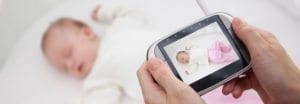
Did you know that disposable diapers are not your only option?
Many parents today are not aware of cloth diapers for their babies. When you think of cloth diapers, most people think they are held together by safety pins and leak often. However, today’s cloth diapers are quite different than how they used to be!
Cloth diapers offer many different easy-to-use features and are environmentally friendly! There are five major types of cloth diapers.
Pre-fold Cloth Diapers :
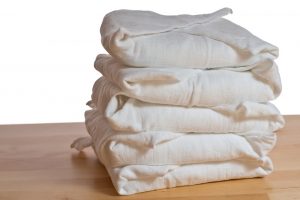 These are the type of cloth diapers that your grandmother might have used. They are rectangular in shape and flat. Pre-folds are meant for you to fold them into a desired shape, fasten it onto your baby, and then add a cover over the pre-fold. The cover is a type of pull on waterproof and quick-dry diaper shell.
These are the type of cloth diapers that your grandmother might have used. They are rectangular in shape and flat. Pre-folds are meant for you to fold them into a desired shape, fasten it onto your baby, and then add a cover over the pre-fold. The cover is a type of pull on waterproof and quick-dry diaper shell.
Pro: These are great for people on a budget. They are very easy to clean and dry.
Con: You will need to purchase different sizes as your baby grows. If you are using a larger size on a smaller baby this diaper may be quite bulky and require an extra fastener to keep it together.
Fitted Cloth Diapers :
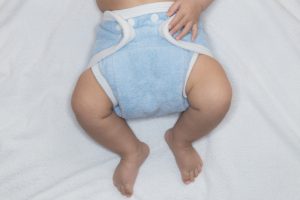 Fitted diapers are most like disposables in their design. These are the diapers that are made up of multiple layers of absorbent materials. They are an hourglass shape and have elastic over the legs and back and will fasten onto the baby with a hook and loop closure or snaps. These type of diapers do not have a waterproof cover attached. So you would need a cover just like the pre-folds. Fitted cloth diapers are designed to fit right over the baby’s body and do not require any folding like pre-folds.
Fitted diapers are most like disposables in their design. These are the diapers that are made up of multiple layers of absorbent materials. They are an hourglass shape and have elastic over the legs and back and will fasten onto the baby with a hook and loop closure or snaps. These type of diapers do not have a waterproof cover attached. So you would need a cover just like the pre-folds. Fitted cloth diapers are designed to fit right over the baby’s body and do not require any folding like pre-folds.
Pro: Some brands may offer a one-size with different snap sizes within the diaper to allow it to grow along with the baby. They are highly absorbent and great at containing messes.
Con: Many fitted diapers come pre-sized and will require you to buy larger sizes as the baby grows. These diapers are not waterproof.
Pocket Diapers :
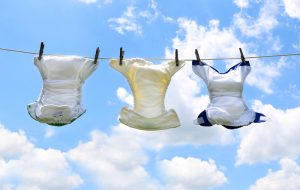 Pocket diapers are considered the first “modern diaper.” They have a waterproof cover that has a “stay dry” polyester lining that is a pocket between the cover and the inner lining. This allows you to put the absorbent pad or prefold within to the pocket. The inner fabric is designed to help keep the baby comfortable and it fastens with snaps or tabs. It is important to make sure that only synthetic fibers keep in contact with your baby’s skin when using these diapers.
Pocket diapers are considered the first “modern diaper.” They have a waterproof cover that has a “stay dry” polyester lining that is a pocket between the cover and the inner lining. This allows you to put the absorbent pad or prefold within to the pocket. The inner fabric is designed to help keep the baby comfortable and it fastens with snaps or tabs. It is important to make sure that only synthetic fibers keep in contact with your baby’s skin when using these diapers.
Pro: You can stuff the diapers to add absorbency for heavy wetters. They do not require covers and are easy to put on baby.
Con: These diapers tend to be bulky, especially when the baby is smaller. You also need to “unstuff” the pocket when changing the baby. That means you have to get your hands a little dirty and remove the pocket from the inside of the diaper before placing it into a wet bag.
All in One Diapers :
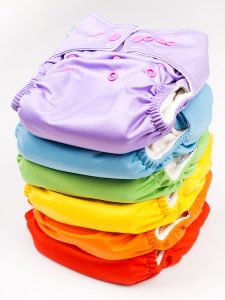 These diapers are very similar to disposables as in the idea of “one wear, one wash,” which makes them quite simple to switch over if you are concerned about the cloth diaper process. All in One diapers- (AIO) are a one piece diaper that is built up of absorbent layers and sewn inside of an outer waterproof cover. They usually fasten with buttons or snaps.
These diapers are very similar to disposables as in the idea of “one wear, one wash,” which makes them quite simple to switch over if you are concerned about the cloth diaper process. All in One diapers- (AIO) are a one piece diaper that is built up of absorbent layers and sewn inside of an outer waterproof cover. They usually fasten with buttons or snaps.
Pro: They are convenient for quick diaper changes. You can add an extra absorbent layer for nighttime or heavy wetters. They are very user friendly!
Con: Some brands require a longer drying time than others.
Hybrid Cloth Diapers:
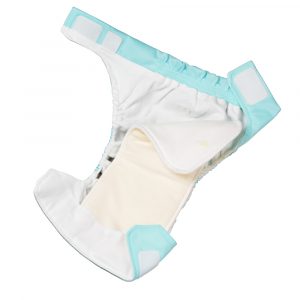 Hybrid diapers, also called All-in-Twos, consist of a diaper cover that you insert an assortment of absorbency layers into. These absorbent layers can be either cloth or disposable, which is why this is considered a hybrid. The diaper cover has elastic around the legs and back.
Hybrid diapers, also called All-in-Twos, consist of a diaper cover that you insert an assortment of absorbency layers into. These absorbent layers can be either cloth or disposable, which is why this is considered a hybrid. The diaper cover has elastic around the legs and back.
Pro: This allows parents to use cloth at home, but use disposables while traveling or at daycare. They offer flexibility for the parent and some covers can also be used multiple times before washes.
Con: They come in different sizes, so you would need to purchase larger sizes as the baby grows. They lack a contoured fit for the absorbent layers so there can be some leakage.
You may be wondering, but what do I do with the poop and pee filled diapers! Well there are a few ways that you can store your dirty diapers until laundry day.
- Wet Bags – These are waterproof bags that you can use instead of a diaper pail. They are used to hold dirty cloth diapers, wipes, covers, or clothes. These can be hung on a hook or a doorknob. Wet bags come in different shapes and sizes. Some are small enough to carry in your diaper bag for small outings and some can hold a few days worth of diapers.
- Diaper Pails- You can use most diaper pails that are available for disposable diapers. The only difference is that you will use a liner that is designed to wash alongside of your diapers. Or some diaper pails even offer disposable liners like garbage bags. It is best to make sure that your pail has a lid to help keep children and pets out of the mess.
There are a few different accessories that you will need along your cloth diaper journey. We have put together a list of some of them.
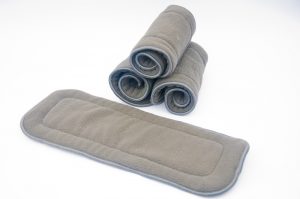 Inserts
Inserts
These are what you will put into your baby’s diaper to help absorb more moisture. Some inserts will be microfiber and will be tucked into the pocket of the diaper. Other inserts are topped with a stay-dry fabric that will be comfortable against your baby’s skin.
You can add additional inserts to pocket and all in one diapers to help improve the absorbency. They can be made from materials such as terry cloth, hemp, cotton, or bamboo.
Liners
Liners help to wick away moisture from your baby’s skin and into the diaper. They are often made from fabric, such as fleece. Disposable liners are made of paper and can help to protect the diaper from lotions or creams that you may use. They also help to make handling the poop a little easier. Some disposable liners can be put right into the toilet and flushed away.
Cloth liners can also help protect against creams used, but need to be washed separately from the diapers.
Wipes
If you are cloth diapering you can still use disposable wipes if you wish. There are wipes that are flushable or that can be thrown directly into the trash available. If you are doing this, it is important to keep them seperate from the dirty cloth diapers so that they do not end up in the wash.
Cloth wipes are also an option. These are fabric wipes that can be wet with warm water and then placed into the same wet bag as the diapers.
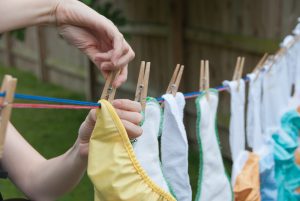 One thing that can help with cleaning cloth diapers is called a diaper sprayer. These are attached to the toilet and help to rinse the poop from the diaper directly into the toilet. They are similar to a sink sprayer and connect to the same water supply as the toilet tank. While these are not necessary, they do help make the process go a little smoother!
One thing that can help with cleaning cloth diapers is called a diaper sprayer. These are attached to the toilet and help to rinse the poop from the diaper directly into the toilet. They are similar to a sink sprayer and connect to the same water supply as the toilet tank. While these are not necessary, they do help make the process go a little smoother!
Cloth diapers are washed in your washer and dryer at home! Each brand has a slightly different routine for each diaper. Most can be washed within two – three runs of the washing machine. Some diapers can be directly placed into the dryer and others must hang dry. It is important to pay attention to the recommended wash routine for the diapers you purchase, as this will help to extend the life of your cloth diapers.
The amount of times that you will need to wash your diapers a week will depend on how many you have and how many diapers your little ones goes through a day. For example, if you have 20 – 30 diapers you should be able to wash every two – four days depending on the above.
The age and weight limits will differ depending on the brand and diapers. Many pocket and all-in-one diapers offer snaps that grow with your baby. Diapers like this will work for babies eight pounds up to 35 pounds. Newborn cloth diapers are also available for babies smaller than eight pounds at birth.
There are many different brands available when it comes to cloth diapers. Depending on the type and brand that you choose, cloth diapers usually range from three dollars all the way up to 35 dollars each.
One great thing about cloth diapers, however, is that you can buy them used from marketplaces online at a discounted cost. Cloth diapers can be bleached which helps to ensure that they are clean for your baby!
Why Use Cloth?
The great thing about cloth diapers is that you can reuse them for each of your children! This will help to save you money in the long-term compared to that of disposable diapers. Keep in mind your water and power bill may increase slightly due to more laundry, but in the end it shouldn’t be that much.
Cloth diapers can be purchased at many different baby stores, as well as many different websites. While some think of cloth diapers as a way of the past, today’s diapers have made great strides for the modern day parent!

